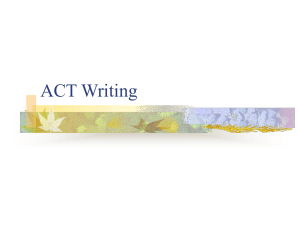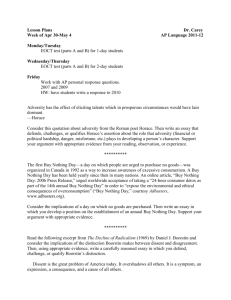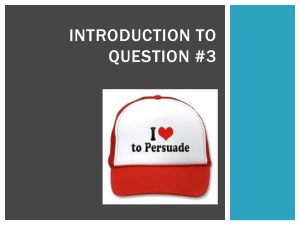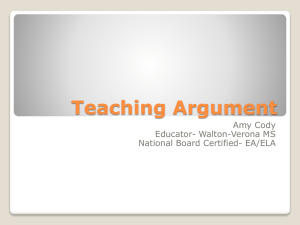argument-models-and-ap-prompt
advertisement
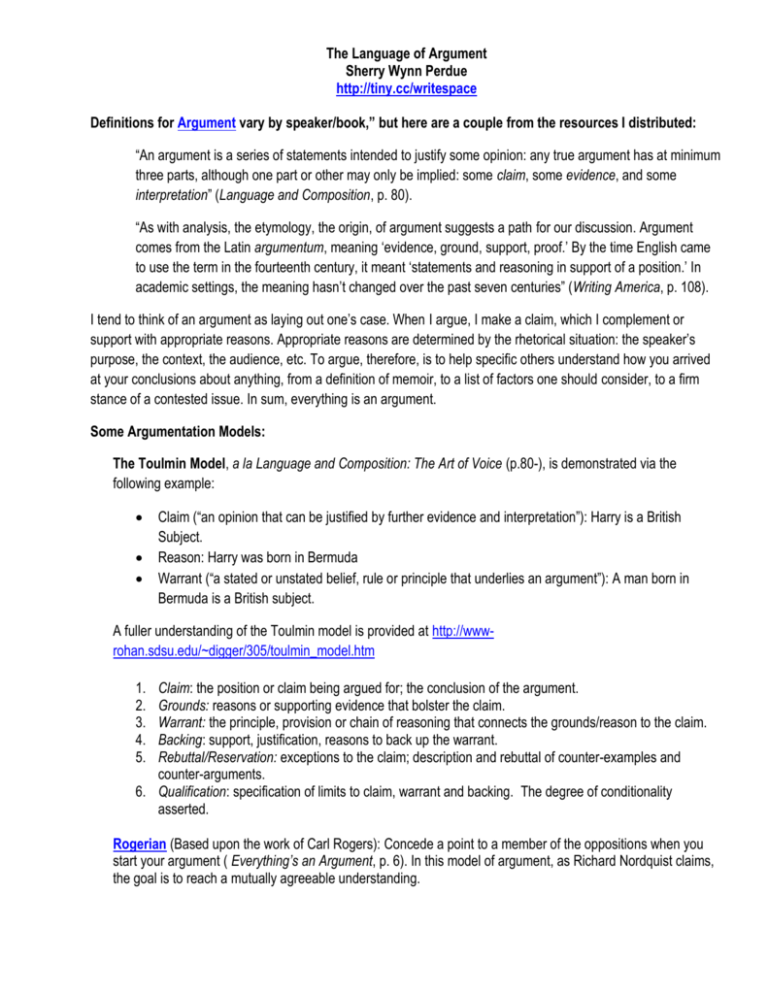
The Language of Argument Sherry Wynn Perdue http://tiny.cc/writespace Definitions for Argument vary by speaker/book,” but here are a couple from the resources I distributed: “An argument is a series of statements intended to justify some opinion: any true argument has at minimum three parts, although one part or other may only be implied: some claim, some evidence, and some interpretation” (Language and Composition, p. 80). “As with analysis, the etymology, the origin, of argument suggests a path for our discussion. Argument comes from the Latin argumentum, meaning ‘evidence, ground, support, proof.’ By the time English came to use the term in the fourteenth century, it meant ‘statements and reasoning in support of a position.’ In academic settings, the meaning hasn’t changed over the past seven centuries” (Writing America, p. 108). I tend to think of an argument as laying out one’s case. When I argue, I make a claim, which I complement or support with appropriate reasons. Appropriate reasons are determined by the rhetorical situation: the speaker’s purpose, the context, the audience, etc. To argue, therefore, is to help specific others understand how you arrived at your conclusions about anything, from a definition of memoir, to a list of factors one should consider, to a firm stance of a contested issue. In sum, everything is an argument. Some Argumentation Models: The Toulmin Model, a la Language and Composition: The Art of Voice (p.80-), is demonstrated via the following example: Claim (“an opinion that can be justified by further evidence and interpretation”): Harry is a British Subject. Reason: Harry was born in Bermuda Warrant (“a stated or unstated belief, rule or principle that underlies an argument”): A man born in Bermuda is a British subject. A fuller understanding of the Toulmin model is provided at http://wwwrohan.sdsu.edu/~digger/305/toulmin_model.htm 1. 2. 3. 4. 5. Claim: the position or claim being argued for; the conclusion of the argument. Grounds: reasons or supporting evidence that bolster the claim. Warrant: the principle, provision or chain of reasoning that connects the grounds/reason to the claim. Backing: support, justification, reasons to back up the warrant. Rebuttal/Reservation: exceptions to the claim; description and rebuttal of counter-examples and counter-arguments. 6. Qualification: specification of limits to claim, warrant and backing. The degree of conditionality asserted. Rogerian (Based upon the work of Carl Rogers): Concede a point to a member of the oppositions when you start your argument ( Everything’s an Argument, p. 6). In this model of argument, as Richard Nordquist claims, the goal is to reach a mutually agreeable understanding. Monroe’s Motivated Sequence Attention Need Satisfaction Visualization Action Some Terminology The Appeals (See Purdue Owl) Pathos (audience focus): appeal to the audience via its sensibilities, its emotions. Ethos (author focus): appeal to credibility via the sources and authorities and commonplaces to which the author refers. Ethos is about the speaker/author’s authority and trustworthiness. Logos (content focus): appeal to reasons, which is demonstrated in the structure/organization and content of the message Kairos (settting focus): appeal to setting ( regarding time and place) Deductive (move from claim to specific support) and Inductive Development (move form specific examples to a claim) Pedagogical Ideas: Place more emphasis on expository than strongly persuasive or polemic arguments. In other words, have students compose arguments that “name factors that decision makers should consider before making decisions” rather than arguments than “mandate a specific choice or position on an issue. Spend a significant amount of time over several sessions unpacking previous AP argument prompts to ensure that students understand what they are and are not being asked to do. When you assign more persuasive arguments, borrow a page from forensics. Assign each student a specific position rather than allowing them to choose. Or, have students compose a rough draft that expresses their initial position. Then compel students to redraft the paper with the opposite viewpoint and move it through the whole process. Expose students to multiple methods for composing arguments. Math students might prefer the format of Toulmin, for example. Past AP Prompts (2013-2008) (2014): Authors Po Bronson and Ashley Merryman published “The Creativity Crisis” in Newsweek.com in July 2010. They reported that the Torrance Test, a test of creativity that has been administered to millions of people worldwide in 50 languages, indicates that the public’s “creativity quotient” has steadily crept downward since 1990. In their article, Bronson and Merryman cite the claim of Professor Kyung Hee Kim at the College of William and Mary: “It’s very clear, and the decrease is very significant.” Kim reports that it is the scores of younger children in America—from kindergarten through sixth grade—for whom the decline is “most serious.” Bronson and Merryman state that “[t]he potential consequences are sweeping. The necessity of human ingenuity is undisputed. A recent IBM poll of 1,500 CEOs identified creativity as the No. 1 ‘leadership competency’ of the future. Yet it’s not just about sustaining our nation’s economic growth. All around us are matters of national and international importance that are crying out for creative solutions, from saving the Gulf of Mexico to bringing peace to Afghanistan to delivering health care. Such solutions emerge from a healthy marketplace of ideas, sustained by a populace constantly contributing original ideas and receptive to the ideas of others.” One possible approach to this reputed decline in creativity is to explicitly teach creative thinking in school. Write to your school board explaining what you mean by creativity and arguing for or against the creation of a class in creativity. (2013): For centuries, prominent thinkers have pondered the relationship between ownership and the development of self (identity), ultimately asking the question, “What does it mean to own something?” Plato argues that owning objects is detrimental to a person’s character/ Aristotle claims that ownership of tangible goods helps to develop moral character. Twentieth-century philosopher Jean-Paul Sartre proposes that ownership extends beyond objects to include intangible things as well. In Sartre’s view, becoming proficient in some skill and knowing something thoroughly means that we “own” it. Think about the differing views of ownership. Then write an essay in which you explain your position on the relationship between ownership and sense of self. Use appropriate evidence from your reading, experience, or observations to support your argument. (2012): Consider the distinct perspectives expressed in the following statements. If you develop the absolute sense of certainty that powerful beliefs provide, then you can get yourself to accomplish virtually anything, including those things that other people are certain are impossible. William Lyon Phelps, American educator, journalist, and professor (1865-1943) I think we ought always to entertain our opinions with some measure of doubt. I shouldn’t wish people dogmatically to believe any philosophy, not even mine. Bertrand Russell, British author, mathematician, and philosopher (1872-1970) In a well-organized essay, take a position on the relationship between certainty and doubt. Support your argument with appropriate evidence and examples. (2011): The following passage is from Rights of Man, a book written by the pamphleteer Thomas Paine in 1791. Born in England, Paine was an intellectual, a revolutionary, and a supporter of American independence from England. Read the passage carefully. Then write an essay that examines the extent to which Paine’s characterization of America holds true today. Use appropriate evidence to support your argument. If there is a country in the world, where concord, according to common calculation, would be least expected, it is America. Made up, as it is, of people from different nations, accustomed to different forms and habits of government, speaking different languages, and more different in their modes of worship, it would appear that the union of such a people was impracticable; but by the simple operation of constructing government on the principles of society and the rights of man, every difficulty retires, and all the parts are brought into cordial unison. There, the poor are not oppressed, the rich are not privileged. . . . Their taxes are few, because their government is just; and as there is nothing to render them wretched, there is nothing to engender riots and tumults. (2011b): American essayist and social critic H. L. Mencken (1880–1956) wrote, “The average man does not want to be free. He simply wants to be safe.” In a well-written essay, examine the extent to which Mencken’s observation applies to contemporary society, supporting your position with appropriate evidence. (2010): In his 2004 book, Status Anxiety, Alain de Botton argues that the chief aim of humorists is not merely to entertain but “to convey with impunity messages that might be dangerous or impossible to state directly.” Because society allows humorists to say things that other people cannot or will not say, de Botton sees humorists as serving a vital function in society. Think about the implications of de Botton’s view of the role of humorists (cartoonists, stand-up comics, satirical writers, hosts of television programs, etc.). Then write an essay that defends, challenges, or qualifies de Botton’s claim about the vital role of humorists. Use specific, appropriate evidence to develop your position. (2010b): The first Buy Nothing Day—a day on which people are urged to purchase no goods—was organized in Canada in 1992 as a way to increase awareness of excessive consumerism. A Buy Nothing Day has been held yearly since then in many nations. An online article, “Buy Nothing Day: 2006 Press Release,” urged worldwide acceptance of taking a “24-hour consumer detox as part of the 14th annual Buy Nothing Day” in order to “expose the environmental and ethical consequences of overconsumption” (“Buy Nothing Day,” courtesy Adbusters, www.adbusters.org). Consider the implications of a day on which no goods are purchased. Then write an essay in which you develop a position on the establishment of an annual Buy Nothing Day. Support your argument with appropriate evidence. (2009): Adversity has the effect of eliciting talents which in prosperous circumstances would have lain dormant. —Horace Consider this quotation about adversity from the Roman poet Horace. Then write an essay that defends, challenges, or qualifies Horace’s assertion about the role that adversity (financial or political hardship, danger, misfortune, etc.) plays in developing a person’s character. Support your argument with appropriate evidence from your reading, observation, or experience. (2009b): The passage below is from The Worst Years of Our Lives by Barbara Ehrenreich. Ehrenreich is writing about life in the 1980s. Read the passage carefully and then write an essay in which you support, refute, or qualify Ehrenreich’s assertions about television. Support your argument with appropriate evidence. Only after many months of viewing did I begin to understand the force that has transformed the American people into root vegetables. If you watch TV for a very long time, day in, day out, you will 5 begin to notice something eerie and unnatural about the world portrayed therein. I don’t mean that it is two-dimensional or lacks a well-developed critique of the capitalist consumer culture or something superficial like that. I mean something so deeply 10 obvious that it’s almost scary: when you watch television, you will see people doing many things— chasing fast cars, drinking lite beer, shooting each other at close range, etc. But you will never see people watching television. Well, maybe for a second, 15 before the phone rings or a brand-new, multiracial adopted child walks into the house. But never really watching, hour after hour, the way real people do. Way back in the beginning of the television era, this was not so strange, because real people actually 20 did many of the things people do on TV, even if it was only bickering with their mothers-in-law about which toilet paper to buy. But modern people, i.e., couch potatoes, do nothing that is ever shown on television (because it is either dangerous or would 25 involve getting up from the couch). And what they do do—watch television—is far too boring to be televised for more than a fraction of a second, not even by Andy Warhol,* bless his boredom-proof little heart. 30 So why do we keep on watching? * Artist and filmmaker known for using repeated images and for making movies dealing with time, boredom, and repetition Reprinted by permission of International Creative Management, Inc. Copyright © 1991 by Barbara Ehrenreich. (2008): For years corporations have sponsored high school sports. Their ads are found on the outfield fence at baseball parks or on the walls of the gymnasium, the football stadium, or even the locker room. Corporate logos are even found on players’ uniforms. But some schools have moved beyond corporate sponsorship of sports to allowing “corporate partners” to place their names and ads on all kinds of school facilities—libraries, music rooms, cafeterias. Some schools accept money to require students to watch Channel One, a news program that includes advertising. And schools often negotiate exclusive contracts with soft drink or clothing companies. Some people argue that corporate partnerships are a necessity for cash-strapped schools. Others argue that schools should provide an environment free from ads and corporate influence. Using appropriate evidence, write an essay in which you evaluate the pros and cons of corporate sponsorship for schools and indicate why you find one position more persuasive than the other. (2008b): Read the following excerpt from The Decline of Radicalism (1969) by Daniel J. Boorstin and consider the implications of the distinction Boorstin makes between dissent and disagreement. Then, using appropriate evidence, write a carefully reasoned essay in which you defend, challenge, or qualify Boorstin’s distinction. Dissent is the great problem of America today. It overshadows all others. It is a symptom, an expression, a consequence, and a cause of all others. I say dissent and not disagreement. And it is the distinction between dissent and disagreement which I really want to make. Disagreement produces debate but dissent produces dissension. Dissent (which comes from the Latin, dis and sentire) means originally to feel apart from others. People who disagree have an argument, but people who dissent have a quarrel. People may disagree and both may count themselves in the majority. But a person who dissents is by definition in a minority. A liberal society thrives on disagreement but is killed by dissension. Disagreement is the life blood of democracy, dissension is its cancer.


